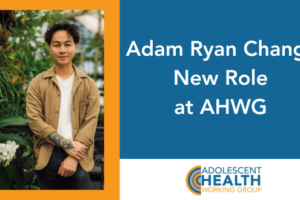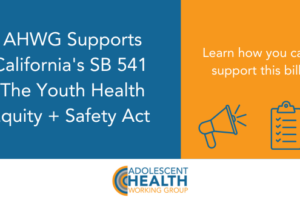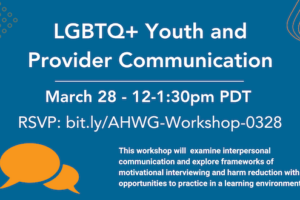
Disruptive Innovations – Advancing HIV/HCV/STD Services for Youth Experiencing Homelessness Through a Collective Impact Model
On Thursday, November 21, 2019, the Adolescent Health Working Group (AHWG) hosted its first Collective Impact and Strategic Planning Meeting with a focus on sexual and behavioral health services, and overdose prevention for youth experiencing homelessness in San Francisco. Ample data has revealed that HIV/HCV/STD rates are on the rise in this community. It is also abundantly clear that addressing the need for stable housing, employment, and financial security greatly improves the likelihood that an individual will access healthcare routinely. We convened a group of youth providers, activists, public health leaders, and youth who are unhoused to examine existing health services and resources available in the region. The group was tasked with identifying successful programs that addressed the immediate needs of youth who are unhoused, but moreover, to imagine what new approaches could be implemented if funds were made available.
The first strategic planning meeting was generously hosted by the San Francisco Community Health Center with stakeholders from Huckleberry Youth Programs, Glide, Facente Consulting, LYRIC, Homebase, San Francisco Department of Public Health, and the Coalition on Homelessness.
The 2019 Census “Point-in-Time” (PIT) Count reported that 27% of youth experiencing homelessness identify as Hispanic/Latinx, 29% Black/African American, and 41% Multi-racial. Since homelessness is a factor for HIV risk, homeless youth are at a higher risk of contracting HIV due to the fact that they are without shelter, and the stigma attached to HIV/HCV/STD can prevent them from seeking care.
The working group brainstormed and identified key themes in their strategies for funding HIV/HCV/STD prevention and care services including: (a) increased transportation options for homeless AYA to access services, (b) examining what services should be made mobile (as opposed to existing in a traditional clinic space), (c) youth leadership should serve as an actual pathway towards long-term employment, and (d) even with existing peer-to-peer training models, more resources are needed to disseminate information about existing programs/services and that youth leaders themselves need more support and tools to conduct outreach.
The working group also emphasized that providing housing and employment opportunities was an immediate step towards ending homelessness and the HIV epidemic altogether. Based on the PIT Count, obstacles to permanent housing were reported at 48% of youth not being able to afford housing and 35% not having employment to acquire housing. It is important to note that the statistics stated in the PIT Count are under-counting and under-representing the reality of homelessness in San Francisco and that the numbers are likely to be twice as high.
Despite these startling figures, youth participants and stakeholders at the meeting show such enthusiasm and hope for what new innovations and ideas this strategic planning process will bring about in the new year. If you are a provider or community member and interested in attending our second strategic planning gathering on December 19, 2019, at 11am, please RSVP by completing our short online form here. Lunch will be provided to all participants.
Quotes from attendees:
“You [AHWG] asked me to dream so I came with my dreams and ideas.”
“If someone is [HIV] positive and wants to be on PrEP, going to clinics can be traumatic for youth.”
“The feedback we got from our [youth] participants is gratitude to have [a] space to talk about challenging issues.”
“This group makes me feel safe and welcomed. I feel safe enough to share.”
“Support youth leaders who are doing peer-support work, not just give gift cards that under appreciate the real work. Look for ways to adequately compensate people … not to just pay an amount that compromises their federal assisted funds.”
“Nothing for us without us. Grateful for AHWG and the youth here taking the time out of their lives to attend this meeting.”
“I’m leaving this meeting filled with tons of hope; different voices and perspectives here are robust and everything felt great and hopeful.”



